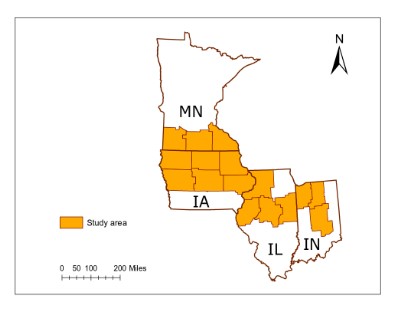By Vijaya Joshi
In the central U.S. Corn Belt, corn and soybean production is mostly rainfed and highly relies on in-season weather conditions for successful crop production. Weather variability alone explains more than 75% of corn yield variation in several areas of this region. Rainfall and air temperature during the growing season play a significant role in spatial and temporal variation in corn and soybean yields, and therefore can be used to develop yield estimation models. These models provide opportunities to estimate crop yield prior to harvest, which can be beneficial for farmers to make informed decisions on marketing and post-harvest farm management.
In order to develop yield estimation models for corn and soybean, a study was conducted using weather data (May to August) and corn and soybean grain yields from 1990 to 2017. The study included 169 counties from agricultural districts in Minnesota, Iowa, Illinois, and Indiana (Fig. 1). Weekly, biweekly, and monthly average air temperature, diurnal air temperature difference (difference between daily maximum and minimum air temperatures), and total rainfall data at the county level were used with county-average annual corn and soybean grain yields for model development. Three types of statistical models were assessed, including multiple linear regression, general additive, and support vector machine (SVM) models.

Fig. 1. States and their agricultural districts included
in this study.
Key findings